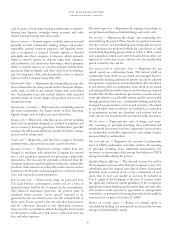American Express 2008 Annual Report Download - page 58
Download and view the complete annual report
Please find page 58 of the 2008 American Express annual report below. You can navigate through the pages in the report by either clicking on the pages listed below, or by using the keyword search tool below to find specific information within the annual report.2008 financial review
american express company
expense of $3.9 billion in 2007 were $520 million or 16 percent
higher due to growth in merchant-related revenues, primarily
generated from the increase in global card billed business of
15 percent, higher GNS-related revenues, and the completion
of independent operator agreements in Brazil, Malaysia, and
Indonesia in 2006.
Provisions for Losses
Provisions for losses increased $24 million or 23 percent to
$127 million in 2008 compared to 2007, primarily reflecting
merchant-related provisions. Provisions for losses in 2007
increased $40 million or 63 percent to $103 million due to
higher merchant-related bankruptcies.
Expenses
During 2008, Global Network & Merchant Services’
expenses increased $284 million or 13 percent to $2.5 billion
due to increased salaries and employee benefits and other
operating expenses, partially offset by a decrease in marketing
and promotion expenses. Expenses in 2008, 2007, and
2006, included $31 million, $6 million, and $8 million of
reengineering costs, respectively, primarily related to the
Company’s reengineering initiatives in 2008 as previously
discussed and international establishment services in 2007 and
2006. Expenses in 2007 of $2.2 billion were $108 million or
5 percent higher than 2006, primarily due to higher marketing
and promotion expenses and increased salaries and employee
benefits and other operating expenses.
Marketing and promotion expenses decreased $42 million
or 7 percent in 2008 to $553 million, reflecting lower brand
and other marketing and promotion expenses as compared
to incremental business-building costs in 2007. Marketing
and promotion expenses increased 15 percent in 2007 to
$595 million, reflecting an increase in brand, merchant, and
partner-related advertising costs.
Salaries and employee benefits and other operating expenses
increased $326 million or 20 percent to $1.9 billion in 2008,
primarily due to increased merchant-related reserves due to
the challenging economic environment, last year’s gains related
to the sale of the Company’s merchant-related operations in
Russia, greater salaries and employee benefits expense, which
reflected the expansion of the merchant sales force and the costs
related to the Company’s reengineering initiatives in 2008 and
higher volume-related expenses. Salaries and employee benefits
and other operating expenses increased $31 million or 2 percent
to $1.6 billion in 2007, reflecting higher salaries and employee
benefits and volume-related expenses, partially offset by the
pension-related gain in 2007.
Income Taxes
The effective tax rate was 33 percent in 2008 and 34 percent in
2007 and 2006.
corporate & other
Corporate & Other had net income of $168 million and
$454 million in 2008 and 2007, respectively, and net expense
of $126 million in 2006. Net income in 2008 reflected the
$186 million and $172 million after-tax income related to the
MasterCard and Visa litigation settlements, respectively, offset by
a $19 million after-tax charge primarily relating to the ongoing
AEB operations retained by the Company in the first quarter
of 2008. 2008, 2007, and 2006, included $108 million after-
tax, $4 million after-tax, and $20 million after-tax, respectively,
of reengineering costs, primarily related to the Company’s
reengineering initiatives in 2008 as previously discussed.
Net income in 2007 reflected the $700 million after-tax gain
resulting from the initial $1.13 billion due March 31, 2008, from
Visa as part of the litigation settlement. This was partially offset by
a $46 million after-tax litigation related charge, and a $31 million
after-tax charge for the contribution to the American Express
Charitable Fund. Net expense in 2006 also included the $42 million
after-tax gain related to the rebalancing of the Travelers Cheque and
Gift Card investment portfolio.
exposure to airline industry
The Company has multiple co-brand relationships and rewards
partners, of which airlines are one of the most important and
valuable. The Company’s largest airline co-brand partner is Delta
Air Lines (Delta), which merged with Northwest Airlines on
October 29, 2008. On December 9, 2008, the Company announced
that it had agreed to a 7-year extension of its exclusive co-brand
credit card partnerships with Delta, as well as other partnership
arrangements, including Membership Rewards, merchant
acceptance and travel. American Express’ Delta SkyMiles Credit
Card co-brand portfolio accounts for approximately 5 percent of
the Company’s worldwide billed business and less than 15 percent
of worldwide cardmember lending receivables.
In 2008, there were a significant number of airline
bankruptcies and liquidations, driven in part by volatile fuel
costs and weakening economies around the world. Historically,
the Company has not experienced significant revenue declines
when a particular airline scales back or ceases operations due
to a bankruptcy or other financial challenges. This is because
volumes generated by that airline are typically shifted to other
participants in the industry that accept the Company’s card
products. Nonetheless, the Company is exposed to business and
credit risk in the airline industry primarily through business
arrangements where the Company has remitted payment to the
airline for a cardmember purchase of tickets that have not yet
been used or “flown.” In the event that the cardmember is not
able to use the ticket and the Company, based on the facts and
circumstances, credits the cardmember for the unused ticket,
this business arrangement creates a potential exposure for the
Company. This credit exposure is included in the maximum
56
























